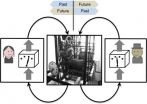(Press-News.org) This press release is available in German.
One of the most deeply rooted concepts in science and in our everyday life is causality; the idea that events in the present are caused by events in the past and, in turn, act as causes for what happens in the future. If an event A is a cause of an effect B, then B cannot be a cause of A. Now theoretical physicists from the University of Vienna and the Université Libre de Bruxelles have shown that in quantum mechanics it is possible to conceive situations in which a single event can be both, a cause and an effect of another one. The findings will be published this week in "Nature Communications".
Although it is still not known if such situations can be actually found in nature, the sheer possibility that they could exist may have far-reaching implications for the foundations of quantum mechanics, quantum gravity and quantum computing.
Causal relations: who influences whom
In everyday life and in classical physics, events are ordered in time: a cause can only influence an effect in its future not in its past. As a simple example, imagine a person, Alice, walking into a room and finding there a piece of paper. After reading what is written on the paper Alice erases the message and leaves her own message on the piece of paper. Another person, Bob, walks into the same room at some other time and does the same: he reads, erases and re-writes some message on the paper. If Bob enters the room after Alice, he will be able to read what she wrote; however Alice will not have a chance to know Bob's message. In this case, Alice's writing is the "cause" and what Bob reads the "effect". Each time the two repeat the procedure, only one will be able to read what the other wrote. Even if they don't have watches and don't know who enters the room first, they can deduce it by what they write and read on the paper. For example, Alice might write "Alice was here today", such that if Bob reads the message, he will know that he came to the room after her.
Quantum violation of causal order
As long as only the laws of classical physics are allowed, the order of events is fixed: either Bob or Alice is first to enter the room and leave a message for the other person. When quantum mechanics enters into play, however, the picture may change drastically. According to quantum mechanics, objects can lose their well-defined classical properties, such as e.g. a particle that can be at two different locations at the same time. In quantum physics this is called a "superposition". Now an international team of physicists led by Caslav Brukner from the University of Vienna have shown that even the causal order of events could be in such a superposition. If - in our example - Alice and Bob have a quantum system instead of an ordinary piece of paper to write their messages on, they can end up in a situation where each of them can read a part of the message written by the other. Effectively, one has a superposition of two situations: "Alice enters the room first and leaves a message before Bob" and "Bob enters the room first and leaves a message before Alice".
"Such a superposition, however, has not been considered in the standard formulation of quantum mechanics since the theory always assumes a definite causal order between events", says Ognyan Oreshkov from the Université Libre de Bruxelles (formerly University of Vienna). "But if we believe that quantum mechanics governs all phenomena, it is natural to expect that the order of events could also be indefinite, similarly to the location of a particle or its velocity", adds Fabio Costa from the University of Vienna.
The work provides an important step towards understanding that definite causal order might not be a mandatory property of nature. "The real challenge is finding out where in nature we should look for superpositions of causal orders", explains Caslav Brukner from the Quantum Optics, Quantum Nanophysics, Quantum Information group of the University of Vienna.
INFORMATION:
Publication:
"Quantum correlations with no causal order"
Ognyan Oreshkov, Fabio Costa, Caslav Brukner. Nature Communications.
DOI: 10.1038/ncomms2076.
Quantum causal relations: A causes B causes A
2012-10-02
ELSE PRESS RELEASES FROM THIS DATE:
Ames Laboratory finds ordered atoms in glass materials
2012-10-02
Scientists at the U.S. Department of Energy's Ames Laboratory have discovered the underlying order in metallic glasses, which may hold the key to the ability to create new high-tech alloys with specific properties.
Glass materials may have a far less randomly arranged structure than formerly thought.
Over the years, the ideas of how metallic glasses form have been evolving, from just a random packing, to very small ordered clusters, to realizing that longer range chemical and topological order exists.
But by studying the structure of a metallic glass alloy formed ...
Use of EHR associated with improvements in outcomes for patients with diabetes
2012-10-02
OAKLAND, Calif., October 1, 2012 — Use of electronic health records was associated with improved drug-treatment intensification, monitoring, and risk-factor control among patients with diabetes, according to a new Kaiser Permanente study.
In the study, which appears in the current issue of Annals of Internal Medicine, researchers also noted greater improvements among patients with poorer control of their diabetes and lipids. The findings provide an important contribution to the evidence base by demonstrating that, for the first time in a large population, EHRs help clinicians ...
Study examines safety of quadrivalent HPV vaccine given to females
2012-10-02
CHICAGO – A study of girls and young women in California suggests that the quadrivalent human papillomavirus vaccine (HPV4) appeared to be associated with syncope (fainting) on the day of vaccination and skin infections in the two weeks after vaccination, according to a report published Online First by Archives of Pediatrics & Adolescent Medicine, a JAMA Network publication.
Human papillomavirus (HPV) is a family of small DNA viruses and infections with this viral family are the most commonly detected sexually transmitted infections in women. While most of these infections ...
Psychiatric disorders persist after youths leave detention
2012-10-02
CHICAGO --- It was a study everyone thought couldn't be done -- tracking, locating and interviewing nearly 2,000 youths up to five years after they were released from juvenile detention in Chicago to assess their mental health.
But a team of intrepid Northwestern Medicine researchers found the young men and women and traveled anywhere necessary to interview them. Many were interviewed after they returned home. Others, however, were interviewed in less conventional locations -- a dancer on a break from her job in a nightclub, a woman in her boyfriend's garbage truck or ...
Study suggests high use of medicare skilled nursing benefit at end of life
2012-10-02
CHICAGO – Almost one-third of older adults received care in a skilled nursing facility in the last six months of life under the Medicare posthospitalization benefit, according to a report published Online First by Archives of Internal Medicine, a JAMA Network publication.
While most Medicare beneficiaries enroll in skilled nursing facility (SNF) care for rehabilitation or life-prolonging care, experience suggests that some dying patients are discharged to a SNF for end-of-life care. Switching patients from Medicare coverage under the SNF benefit to the hospice benefit ...
Psychiatric disorders may persist in some young people after detention
2012-10-02
CHICAGO – A study of juveniles detained in Chicago suggests that more than 45 percent of males and nearly 30 percent of females had one or more psychiatric disorders with associated impairment five years after detention, according to a report published in the October issue of Archives of General Psychiatry, a JAMA Network publication.
Psychiatric disorders are prevalent among incarcerated juveniles. The disorders are likely to persist as the juveniles grow to be young adults because risk factors for psychiatric disorders are common among delinquent youth, including maltreatment, ...
Auto experts recognize cars like most people recognize faces
2012-10-02
When people – and monkeys – look at faces, a special part of their brain that is about the size of a blueberry "lights up." Now, the most detailed brain-mapping study of the area yet conducted has confirmed that it isn't limited to processing faces, as some experts have maintained, but instead serves as a general center of expertise for visual recognition.
Neuroscientists previously established that this region, which is called the fusiform face area (FFA) and is located in the temporal lobe, is responsible for a particularly effective form of visual recognition. But ...
Study affirms safety of HPV4 vaccine for adolescents and young women in routine clinical care
2012-10-02
OAKLAND, Calif. — A study of almost 200,000 young females who received the quadrivalent human papilloma virus (HPV4) vaccine found that immunization was associated only with same-day syncope (fainting) and skin infections in the two weeks after vaccination. These findings support the general safety of routine vaccination with HPV4 in a clinical care setting to prevent cervical and other genital and reproductive cancers.
The association between HPV4 and syncope was not unexpected, the researchers noted, because injections in general are known to have a correlation to fainting, ...
Restricting nuclear power has little effect on the cost of climate policies
2012-10-02
"Questions have been raised if restricting nuclear energy – an option considered by some countries after the accident in Fukushima, Japan – combined with climate policies might get extremely expensive. Our study is a first assessment of the consequences of a broad range of combinations of climate and nuclear policies," lead author Nico Bauer says. Restrictions on nuclear power could be political decisions, but also regulations imposed by safety authorities. Power generation capacities would have to be replaced, but fossil fuels would become costly due to a price on CO2 ...
The Great Barrier Reef has lost half of its coral in the last 27 years
2012-10-02
The Great Barrier Reef has lost half its coral cover in the last 27 years. The loss was due to storm damage (48%), crown of thorns starfish (42%), and bleaching (10%) according to a new study published in the Proceedings of the National Academy of Sciences today by researchers from the Australian Institute of Marine Science (AIMS) in Townsville.
"We can't stop the storms but, perhaps we can stop the starfish. If we can, then the Reef will have more opportunity to adapt to the challenges of rising sea temperatures and ocean acidification, says John Gunn, CEO of AIMS.
...


